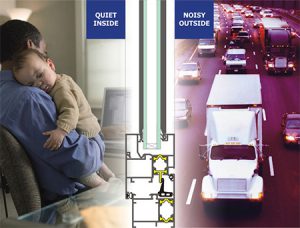The Benefits of Energy Efficient Windows
Comfort
Winter Thermal Comfort
An older window with a lower glass temperature feels colder because more heat is radiated from a person’s body to the window. Cold glass can also create uncomfortable drafts as air next to the window is cooled and drops to the floor. This sets up an air movement pattern that feels drafty and accelerates heat loss. High performance windows with lower U-values will result in a higher interior window temperature in winter and thus greater comfort.
Summer Thermal Comfort
In summer, strong direct sunlight strikes people and interior surfaces, creating overheating and discomfort. Windows with low solar heat gain coefficients will reduce the solar radiation coming through the glass and associated discomfort. Low solar heat gain low-E glass (low emissive) reduces heat gain while still providing sufficient light and view.
Source: Lawrence Berkeley National Laboratory (Lyons and Arasteh).
Cut your energy bills
Heating Season Savings
In climates with a significant heating season, windows have represented a major source of unwanted heat loss, discomfort, and condensation problems. In recent years, windows have undergone a technological revolution. It is now possible to have lower heat loss, less air leakage, and warmer window surfaces that improve comfort and minimize condensation. In cold regions, this means that windows are no longer an energy vacuum to be avoided — increasing glazing area with high performance windows can have little or no affect on total energy use.
Cooling Season Savings
In climates that mainly require cooling, windows have represented a major source of unwanted heat gain. In recent years, windows have undergone a technological revolution. It is now possible to significantly reduce solar heat gain and improve comfort while providing clear views and daylight. In warm regions, this means that high performance windows can face into the sun if desired without great energy penalties — although shading techniques remain important.
Source: Lawrence Berkeley National Laboratory (Lyons and Arasteh).
Both the Albury / Wodonga and Canberra regions are two of the few regions that have an even requirement of heating and cooling in Australia.
Energy efficient windows not only reduce your energy usage, but also mean that you only require a smaller, less expensive air conditioning system. The monthly savings on your energy bills, coupled with a reduction in the initial purchase price of the equipment, can more than offset the initial cost of purchasing more efficient windows.
Quieter Homes
Well insulated windows reduce noise transfer from the outside to the inside which can be a huge benefit for in noisy locations.
Less or No Condensation
In cold climates, energy efficient windows stay warmer, so windows stay dryer. With reduced condensation, mold and mildew are not a problem around windows. This saves curtains and paint from being damaged. Furthermore, with thermally-broken windows, the issue of condensation is almost eliminated as the aluminium on the outside does not touch the inside aluminium.
Reduced Fading
The new coatings on energy efficient windows block out the harmful ultraviolet rays, which cause fading. Coatings on the E-glass can reduce the UV rays by 98 percent. This will save material and woods from losing their bright original colors.
Window Properties
U-value – Heat transfer through a window
The U-value is the rate of heat transferred through a whole window, frame and glass included. The lower the U-value, the greater the window’s resistance to heat flow and the better the window is at insulating the heat transfer. A low U-factor is useful during cold days when heating is needed. A low U-factor is also helpful during hot days when it is important to keep the heat out, but it is less important than SHGC in warm climates. Increasing the quality of the frames and moving to double and triple-glazing are the only way to increase the U-value of the window.
Solar Heat Gain Coefficient (SHGC) – direct sunlight permitted through a window
The solar heat gain coefficient is a fraction of the solar radiation (sunlight) admitted through a window, either directly transmitted and/or absorbed and subsequently released as heat inside the home. The lower a window’s SHGC, the less solar heat it transmits. This is generally achieved through tinting the glass and is most often used on Western and Northern-facing windows
Visible Transmittance – Sunlight through a window
The visible transmittance is the fraction of the visible spectrum of sunlight transmitted through the glass. The higher the visible transmittance, the more daylight is transmitted through the glass.
Air Infiltration – leakage of air through the window
Is the air infiltration through leaks in the whole window. The lower the air infiltration rating, the less air will pass through the window when closed.
Noise Reduction

A window’s ability to reduce noise depends on the frame design and glazing as follows:
- Frame design – Both the uPVC and thermally broken frames achieves a high level of sealing between the frame and sashes. Air and noise infiltration are minimised by a series of sealing systems including the thermal break. All Euro Collection frames have the highest standard of sealing possible to ensure an effective sound barrier.
- Glazing options – Both the uPVC and thermally broken design’s enable the use of various glazing options, so the most suitable option can be chosen for your individual need. Taking into consideration the availability of various glass thicknesses, weights & double or triple glazing options, Ultimate Windows will accommodate the most appropriate glass panel to prevent noise penetration.
Due to the flexibility of Ultimate Windows, we can also provide effective secondary glazing solutions to maximise the acoustic insulation of buildings located in extremely noisy environments.
